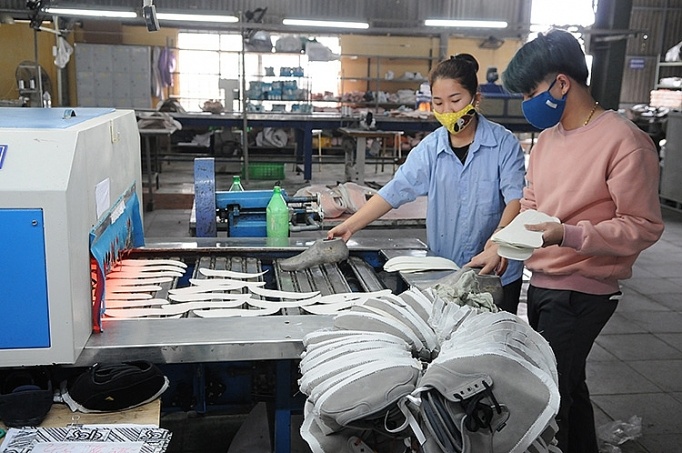Leather and footwear exports continue falling in August
 |
| Leather and footwear exports are continuously dropping due to the pandemic |
According to statistics from the General Statistic Office of Vietnam, in August, the exports of footwear reached $850 million, handbags reached $150 million, respective drops of 38.5 and 37.9 per cent on-year.
This continues the sharp decline since June. In particular, footwear exports decreased from $2 billion to $850 million while handbags decreased from $325 million to $150 million.
Generally, in the first eight months, leather and footwear enterprises have exported $12.6 billion of footwear and $2.1 billion of handbags, up 16.2 and 2.1 per cent on-year.
Total export turnover of leather and footwear to Vietnam's top 5 markets (USA, EU, China, Japan, South Korea) accounted for 81.2 per cent, of which footwear accounted for 80.8 per cent and handbags accounted for 82 .9 per cent.
The US is still Vietnam's largest footwear export market, with footwear accounting for 40.3 per cent and handbags for 44 per cent of Vietnam's total export turnover in the segment. The EU ranks second with 23.4 per cent of footwear and 22.2 per cent of handbag exports. Other markets include China (9.4 and 4.4 per cent), Japan (4.8 and 8.7 per cent), and South Korea (2.9 and 3.7 per cent).
According to the Vietnam Leather, Footwear and Handbag Association (LEFASO), the outbreak of COVID-19 since the beginning of May has affected the production of leather and footwear enterprises in the last months of 2021.
Prolonged social distancing in the southern provinces has forced 80 per cent of leather and footwear factories in Ho Chi Minh City, Dong Nai, Binh Duong, An Giang, and Kien Giang (which are home to many large leather and footwear enterprises) to stop production after they could not comply with authorised operation models. In the central and northern regions, leather and footwear enterprises only operate at 50-70 per cent capacity due to social distancing and labour shortage.
Leather and footwear enterprises suffered great losses due to the cessation and reduction of production, cancellation of export orders, while still having to maintain factories and pay wages to employees.
Operational enterprises must reduce production due to the reduction in employee count. At the same time, these enterprises have to bear lots of costs such as testing, vaccination, food, and accommodation for employees. Moreover, many workers have returned to their hometowns, resulting in a lack of labour force. Additionally, inter-provincial travel and transport is also difficult during the pandemic.
Furthermore, the shortage of containers has raised logistics costs 5-10 times against last year, along with fuel and imported raw material prices, greatly affecting production, causing many difficulties for export enterprises.
In the current situation, businesses need to reduce costs and prepare labour force so that after the pandemic they can immediately restore production and exports, making good use of preferential treatment from free trade agreements, especially the Comprehensive and Progressive Agreement for Trans-Pacific Partnership (CPTPP) and the EU-Vietnam Free Trade Agreement (EVFTA).
What the stars mean:
★ Poor ★ ★ Promising ★★★ Good ★★★★ Very good ★★★★★ Exceptional
Related Contents
Latest News
More News
- PM orders investment model for North–South high-speed rail (December 22, 2025 | 17:43)
- First members of Danang International Finance Centre revealed (December 22, 2025 | 17:39)
- Securing capital and efficiency for Vietnam’s 2026-2030 growth ambitions (December 17, 2025 | 10:00)
- Driving double-digit growth through green and circular transformation in Vietnam (December 17, 2025 | 09:00)
- Vietnam bucking trend in the global M&A landscape (December 16, 2025 | 14:20)
- Vietnam’s green transition demands collective financial action (December 15, 2025 | 12:00)
- VIR workshop highlights capital and policy for sustainable development (December 15, 2025 | 11:00)
- National Assembly approves pilot mechanisms to accelerate major projects in Hanoi (December 12, 2025 | 11:29)
- Vietnam eases policy approval requirements, simplifies foreign and outbound investments (December 11, 2025 | 17:53)
- Unpacking new momentum in Vietnam’s M&A market (December 10, 2025 | 09:59)

 Tag:
Tag:





















 Mobile Version
Mobile Version